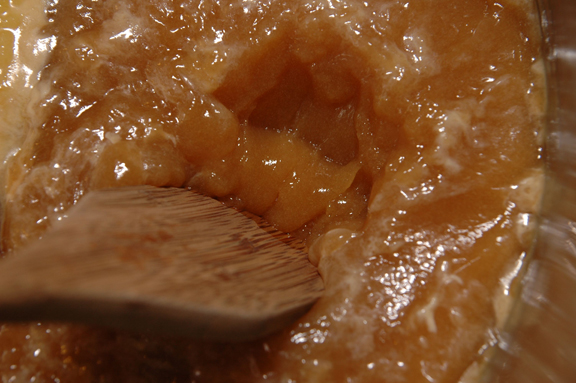- Dec 10, 2015
Homemade stock you say? You are probably thinking to yourself, "I don't have time?" or "There are a lot of store-bought, gluten free options available." or "C'mon, does it really make a difference?" And to all the sayers-of-nay I say, "It is worth it!" and "It is one of the reasons foods prepared in professional kitchens are richer, tastier and more satisfying than those you prepare at home." So, here are a few reasons everyone should make homemade stock:
- Especially for the allergen aware, you control all of the ingredients.
- They are richer and more flavorful than their store-bought counterparts.
- They have better body and viscosity than the pour-like-water, pre-made versions.
- It only take a few hours to make enough stock that pays dividends for weeks.
- You utilize more parts of products you are already paying for.
So beginners and occasional stock makers alike, here are a few tips for getting the most out of the process. First, I want to start off by setting some goals and standards. A good, quality, well-made stock should be:
- Clear not cloudy or greasy
- Gelatinous not thin and watery
- Neutral yet focused in flavor
- Versatile so that it can be a foundational element in your kitchen

All animal stocks, whether they are made from poultry, fish or veal are all comprised of the same basic elements; bones/animal parts, water, vegetables and aromatics. Let's address each of these in turn.
The Bare Bones
This is the base of your homemade stock, and, not all bones are created equal. Different animals and different parts of animals naturally contain different amounts of collagen and connective tissue. These are the elements that, when cooked, create gelatin and give your finished stock that viscous, slick-on-your-lips quality. For the stickiest stock, use joints, knuckles, feet, and bones from young animals. Also, each animal, as it were, requires a different cooking time in order to extract the most out of the parts being used. Here are some big picture guidelines:
Poultry - simmer 4 hours
Fish - simmer 1 hour
Veal - simmer 12 – 18 hours
People always want to know if they can use meat in place of or in addition to the bones, joints and carcass. And while you can, it kind of defeats the purpose of resourcefulness. See, the goal is to have used the meat in other dishes and applications. And do not kid yourself into thinking you will want to eat the meat after it has been cooked for stock. The meat will be tasteless and dusty in texture. It will have given everything it had up the universal solvent.
Veggie Tales
You know the phrase, quality in, quality out! So, do not turn your soon-to-be-stock into a simmering trash collection for all the vegetable scraps in your kitchen. That is called compost. Also, do not use your wilted and tired vegetables. If you would not eat them in their current state, they do not belong in to the pot. As for what you can use, think classic, think neutral. Fennel is delightful, but do you really want everything you make with the stock to have that undercurrent of anise? So, regardless of the stock I am making, I always use the same thing:
- Mirepoix - I am not trying to be pretentious when I say mirepoix, it is a concise way to say a very particular proportion of onion, carrots and celery. It will always be 2 parts onion : 1 part carrots : 1 part celery. For example, if I need 4 lbs of vegetable, I would use 2 lbs onion : 1 lb carrot : 1 lb celery. It just makes things easy.
- Mushroom Stems - Just a handful. Make sure they are free of dirt. Why the stems? Because I have already used the caps for some other dish and do not want to waste the tasty little suckers. Oh yeah, they are a good source of umami.
- Garlic - Resist the urge to add a lot of garlic because you just looovvee garlic. The goal is to gain depth of flavor while staying neutral. You garlic lovers can add all the garlic you want to the individual dishes you prepare. I usually save the small, hard-to-peel cloves for my stocks and throw them in, skin and all.
- Tomato - Less is more. Too much tomato product will turn your finished stock slightly reddish orange.
Size Matters
The size you cut the vegetables really does matter. The goal is to extract all the flavor you can without turning the product into mush that disintegrates into the liquid resulting in a cloudy, particulate filled stock. As you can anticipate, the longer the stock has to cook, the larger the pieces need to be cut. For example, for fish fumet, which has a 1 hour cooking time, I cut the vegetables into 1" pieces. For veal stock, I wash and peel the vegetables but otherwise throw them in whole.
To Roast or Not To Roast
This is entirely up to you! Obviously, roasting the bones and vegetables will yield a darker, richer stock. And while this is delicious, it is not always what you want. When in doubt, unroasted is more versatile, but it is nice to have both on hand. If you do decide to roast the bones and vegetables, do so thoughtfully by using these guidelines:
- Roast the bones separately from the vegetables.
- Cook the different vegetables on separate pans. This gives you the most control. If you combine them all, some might burn while others are just beginning to get golden brown.
- Do not chicken out! The goal is to achieve color, otherwise, why bother? Black or burnt is no good however. This will just lend a bitter quality to the finished stock.
- Deglaze the roasting pan with a little white wine. There are lots of good little bits on the pan that will contribute flavor to your stock.

Aromatics
I keep this very simple and use a classic bouquet garni. Tie parsley stems, thyme springs and bay leaves into a bundle using a piece of leek and some butcher's twine (you can also tie them up in cheesecloth). I then tie this to the pot handle for easy removal later and at any time.
The Down Low on H2O
You would think this would need no further explanation. However, there are two important considerations to consider when thinking about water. First, how much? Obviously, the object of stock-making is to extract flavor and gelatin from the ingredients into the liquid. If you begin with too much water, the finished stock will be thin and watery. So, my standard go-to ratio is 1 gallon of water for every 4 lbs of bones. Also, you must always start with cold water. This allows for maximum extraction in addition to keeping the stock clearer.
Science excerpts from superbeefy.com - If the bones and vegetables are started in cold water, the water-soluble proteins (some proteins are soluble in water; some aren’t) will have ample time to dissolve in the water before being made insoluble and inaccessible by the denaturation process. Also, during this low-temperature stage some undesirable water-soluble impurities, such as those in blood, will have time to dissolve in the water, where they will later coagulate as the water becomes hot. (You know that to remove blood stains from fabrics you soak them in cold water, because hot water would “set” the stain by coagulating the proteins.) During gradual heating from a cold start, these undesirable proteins coagulate slowly throughout the body of the liquid forming relatively large particles of gunk. Meanwhile, some of the fat on the bones will have been melting and rising to the water’s surface. On its journey to the top, the oil will encounter the coagulated protein particles and coat them, acting as a sort of life vest to float them up to the surface as a greasy scum, which you can skim off. On the other hand, in hot-from-the-start water, the impurity proteins would coagulate more rapidly, forming tinier particles of gunk that would neither settle out nor be captured by rising fat. They would stay suspended in the liquid, making it cloudy.
Bones First, Vegetables Later
This is more of a preference than a rule. I allow the water and bones to simmer for about 20 minutes before adding the vegetables and aromatics. The reason is simple. There is a lot of initial gunk that comes to the surface and it is easier to skim off if there are not a bunch of vegetables in the way. Once the surface is clear of the big floaties, I add everything else.
Simmer Never Boil
Of all the tips, this is the one that matters most. So let me say it again - never boil! Your stock should never climb above a simmer. Boiling is just too vigorous and simply unnecessary. When you boil stock, everything gets jostled and breaks apart. The vegetables lose their integrity and fat/impurities get emulsified into the liquid instead of rising to the surface. The resulting stock has a greasy mouth feel, is cloudy and filled with particulate.
Skim the Skum
Not sexy sounding, but evocative nonetheless. I skim the impurities from the stock as it cooks. There is no need to be fanatical about this, just give it a quick skim every once in a while. It is also important to note that you do not want to stir the stock. First, there is no need. Second, the fat and gunk will coagulate in large bits on the surface. These are easy to skim off. Stirring just breaks them apart, dispersing them and making them harder to get.
The Finishing Touch
Strain your stock. You have done all this work, taken all this care; so now use the right tool for the job. You will want a fine mesh chinois. Allow the stock to strain through naturally; do not push or press on the vegetables. They are soft and will break apart easily creating particles. So many of the steps so far have been about creating a clear stock, don't mess it up now in order to get those last two tablespoons of liquid.





 Find our products
Find our products FAQs
FAQs Testimonials
Testimonials R&D Projects
R&D Projects